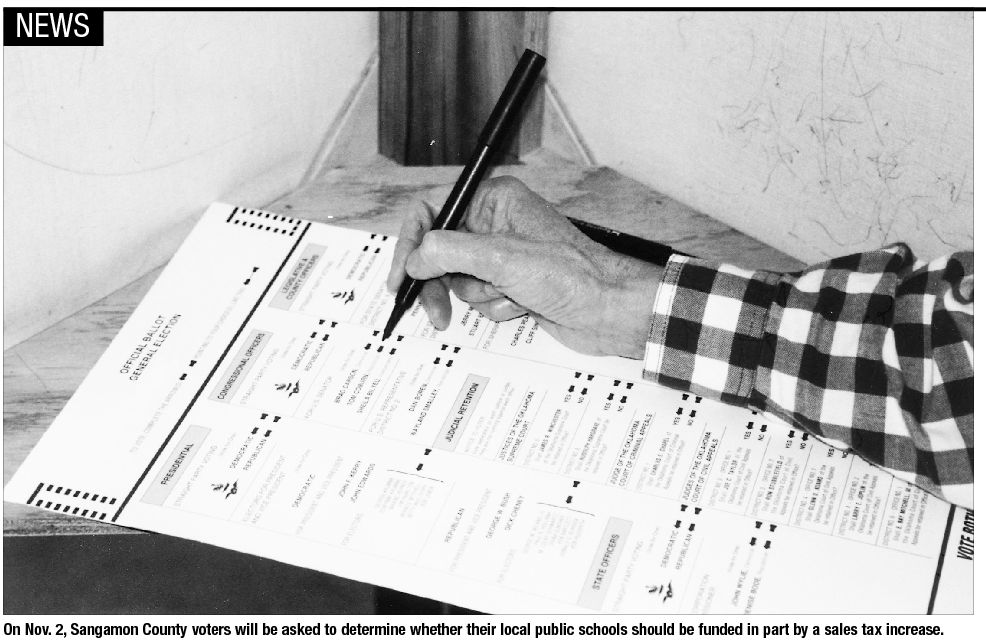
Voters to decide on sales tax for schools
Supporters claim it will ease burden on property tax EDUCATION | Rachel Wells
If voters next week approve a referendum raising Sangamon County’s sales tax rate from 8 percent to a maximum of 9 percent, it would reaffirm a philosophical shift in school funding already begun by the Illinois state legislature, says David Root, superintendent of Williamsville schools.
Without sales tax revenue, school funding in Illinois is based entirely on property taxes, Root explained at a public hearing held by the Sangamon County board to learn more about the upcoming referendum. “The spirit of that is, the quality of your schools dictate, essentially, property values.” Easing the burden on local property taxes by relying in part on a countywide sales tax would be more equitable, he says.
Lawmakers approved sales tax as a funding source for school districts in 2007. Since then, six other counties have implemented sales tax increases. A one percent increase in the county’s sales tax, which is what the schools are seeking, would bring in about $19 to $20 million to county schools. The funds would be divvied up to each district according to enrollment numbers. The sales tax would not apply to medicines, automobiles or most groceries, and its proceeds could only be used for school facility improvements. The Sangamon County board has placed a second referendum on the ballot asking voters whether the board should institute the full 1 percent increase schools are asking for.
Root and superintendents from several other county school districts testified last week at the
public hearing about what projects would be paid for by any sales tax revenues. In the case of Springfield Dist. 186, which hasn’t had a property tax referendum approved since 1984, the money would go toward five new middle school gymnasiums and the addition of 10 new classrooms and a new gym at Southeast High School. If the sales tax referendum is approved, Dist. 186 plans to use 10 percent of its sales tax revenue for reducing property taxes. Without sales tax revenues, the district would eventually seek to raise property taxes in order to accomplish its building needs, Dist. 186 superintendent Walter Milton says.
For other school districts, such as Williamsville, for which voters in 2001 approved a property tax increase for facility improvements, much of the additional funding would go toward reducing existing debt for those projects already completed. One hundred percent of the sales tax proceeds allotted to Williamsville would go immediately toward reducing property taxes, Root says.
“This gives voters the choice, the opportunity, to make a decision on whether or not they would like to shift that burden off of property taxes and utilize revenue generated from people who do not live in the county,” says Root, explaining that about 30 percent of sales tax revenues would come from visiting shoppers.
While county school representatives argue that the sales tax would provide relief for property taxpayers, opponents say it would further
burden those who don’t have enough money to purchase property in the first place. “This tax increase doesn’t happen in a vacuum and we have to remember that there are real sacrifices that have to be made by families,” Kristina Rasmussen, executive vice president of the conservative Illinois Policy Institute, told the county board.
County board member Jim Good, questioning schools’ need for more revenue, likened their situation to that of a business. “I’m a small business owner, and I budget every year to run my business – for my building, for my rent, to pay my employees, for my supplies, to pay taxes, to pay health insurance. As a school district, isn’t part of your function, or budgeting over the years, to plan for buildings and for paying for teachers and administrators, for educating students? Where has it changed … that you don’t budget for buildings any more?” Root says that without asking for and receiving a property tax increase, districts are often limited due to tax cap laws on starting new projects until they’ve paid off bonds for older projects. He says that a sales tax would be a long-term alternative to returning, time after time, to property owners for increases in property taxes. Root adds that if voters don’t approve the sales tax referendum, it’s a signal that the community prefers a reliance on property taxes.
Contact Rachel Wells at [email protected].